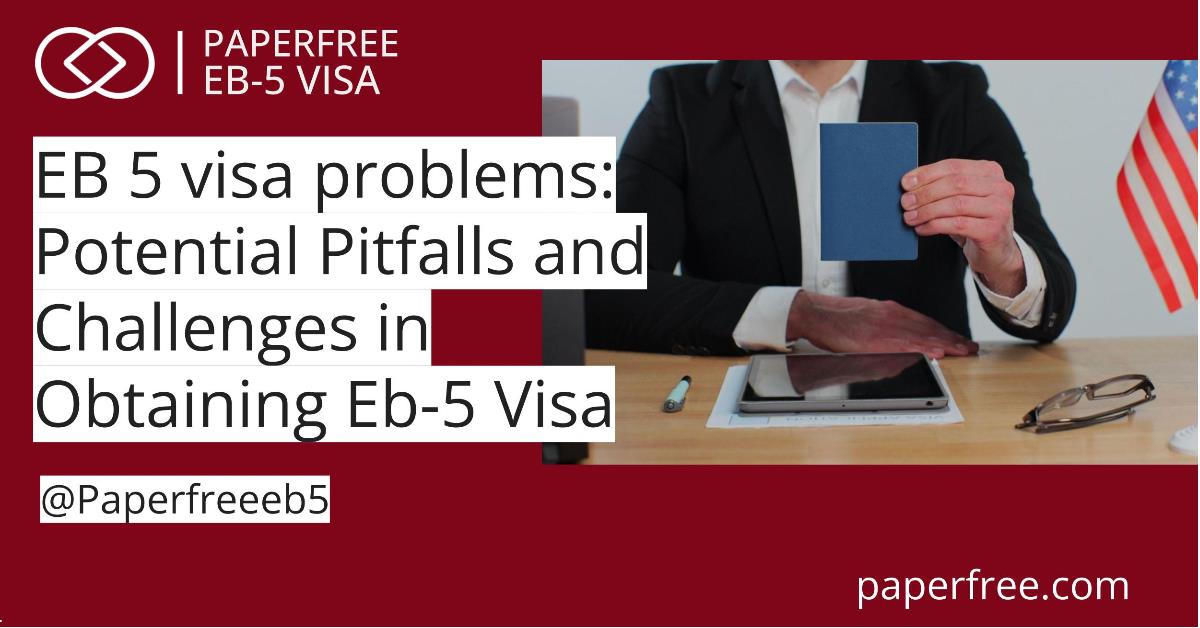EB 5 visa problems: Potential Pitfalls and Challenges in Obtaining Eb-5 Visa
Common challenges and pitfalls that investors may encounter during eb 5 status check. Navigating EB-5 Visa complexities: Understand the potential challenges and prepare for the pitfalls in obtaining U.S. residency.last updated Monday, December 22, 2025
#eb 5 visa problems #eb5 success rate
| | by Sidra Jabeen | Content Manager, Paperfree Magazine |

QUICK LINKS
AD
Get Access to EB 5 Visa Investment Projects
The EB-5 visa program offers a pathway to U.S. permanent residency through investment, but it comes with several significant challenges and pitfalls that prospective applicants must carefully consider. While the opportunity is attractive, the process is complex and fraught with potential pitfalls. This article explores the essential requirements, common challenges, and practical tips for a successful EB-5 application.
Common Reasons for Delay or Denial
| Reason for Delay/Denial | Description |
|---|---|
| Visa Backlogs and Retrogression | High demand leads to waiting lists, especially for certain nationalities. |
| Complicated Source-of-Funds Documentation | Proving the lawful origin of funds can be time-consuming and complex. |
| Petition Errors/Inconsistencies | Mistakes or missing information trigger RFEs or denials. |
| Project Fails to Meet EB-5 Requirements | Insufficient job creation, unqualified projects, or funds not at risk. |
| Inadmissibility Issues | Health, security, or previous immigration violations can bar entry. |
Potential Pitfalls in the EB-5 Visa Process
Source of Funds
While this requirement for the eb5 success rate may appear straightforward, initiating the visa application by submitting the I-526 petition is more complex than it initially seems.
Form I-526 necessitates information about the NCE and detailed documentation regarding the source of the invested funds.
The main goal of this project is to prove that the investor owns the money they're investing and that it was obtained legally. This is necessary to support their application for a visa. To do this, investors can provide different kinds of documents that fall into four main categories: records showing the registration of their business, tax returns or similar documents from the past five years, evidence of other sources of money they have, and copies of any legal cases or proceedings they've been involved in for the past 15 years.
Investment Amount
To be eligible for an EB-5 visa and EB5 backlog, individuals must invest a minimum of $900,000 in a new commercial enterprise (NCE) to create at least ten full-time jobs for American workers.
When investing in the EB-5 program, it's essential to prove where your money comes from, including any fees associated with the investment. This can be tricky if your money comes from various sources, like loans or gifts. It's best to work with an immigration attorney or EB-5 professional to figure out the easiest way to prove the source of your investment funds. Some sources, like personal savings and investments, are easier to prove than others.
Learn more Details on EB5 Investment Amount
Importance of Lawful Source of Funds for EB-5 Investors
In the EB 5 application, USCIS mandates the provision of well-documented evidence to establish the legality of the capital investment and demonstrate a direct link between the investor and the path of funds from their home country to the U.S. investment.
Capital can generally be sourced from any location globally, including the U.S., as long as the investor legally owns it.
Comprehensive documentation regarding the source and path of funds is of paramount importance. The funds necessary for the EB-5 investment may encompass:
- Accumulation of salary
- Earnings from business ownership
- Proceeds from the sale/mortgage of real estate property
- Gifts from Family
- Inheritance
Complex fund tracing often results in larger Source of Funds (SOF) documentation files. These files should include "point in time" events that unequivocally establish ownership of the funds. To demonstrate that the investment funds originate from legal sources, investors should collaborate with their immigration attorney.
While utilizing the proceeds of a loan for the investment is permissible, securing the loan with an asset is advisable as a best practice.
EB 5 Direct Investment vs Regional Center
What is Regional Center EB5 investment?
The Regional Center (RC) is a USCIS-regulated entity aggregating EB-5 capital from multiple foreign investors for job-creating projects within specific geographic regions and industries.
What is Direct EB5 investment?
The direct EB-5 program is a permanent option, while the RC EB-5 program had a sunset date of September 30, 2015, but is expected to be reauthorized for another five years, with proposed legislation aiming to make it permanent.
Direct vs. Reginal Center investment:
- There are approximately 600 plus approved Reginal Centers, and nearly 95% of EB-5 petitions are based on RC investments.
Notably, EB-5 RC investment funds are subject to U.S. securities and anti-fraud laws, with the SEC and USCIS emphasizing the importance of due diligence for foreign investors. - In the direct EB-5 route, foreign nationals achieve immigration goals while investing in a business they manage, potentially yielding significant returns.
- In contrast, RC EB-5 investments typically offer a lower rate of return (0.5-2%), with investors playing a more passive role.
- However, direct EB-5 investors must demonstrate direct employment of ten U.S. workers, whereas RC EB-5 investments rely on a combination of direct, indirect, and induced employment using economic methodologies.
- Most RCs are located in Targeted Employment Areas (TEAs) with a minimum investment of $500,000, but there are direct EB-5 investments that also qualify for reduced capital requirements.
- Both EB-5 options necessitate investor engagement in the "management" of the enterprise, which can be satisfied if the investor holds the rights, powers, and duties typically granted to limited partners under the Uniform Limited Partnership Act.
Choosing between these EB-5 options depends on the investor's circumstances and goals.
Learn more EB5 Investment Projects the Guide. Direct and regional center investment projects.
No Fast Track EB-5 Process and No Guaranteed US Permanent Residence
EB-5 investors do not have a guaranteed path to obtaining a green card by investment due to the extended process and the potential for project failure or significant changes.
There is no expedited processing available for EB-5 petitions. The journey begins with the submission of an I-526 immigrant entrepreneur petition to USCIS, where the investor must establish the legal source of funds, detail the investment's path, and demonstrate the creation of ten U.S. jobs within two years or show that these jobs have already been generated as a result of the investment.
Submitting the I-526 petition alone does not grant the investor the right to reside or work in the U.S. The current average processing time for I-526 petitions is approximately 14 months, and even upon approval, it does not confer permanent residence.
Instead, once the I-526 is approved, if the investor is outside the U.S., they and their dependent family members must apply for immigrant visas at the U.S. Consulate in their home country.
This step involves additional documentation and security checks, extending the process by another 6-12 months. If the investor is already in the U.S. under valid nonimmigrant status, they can adjust their status to become permanent residents, which typically takes about six months.
Therefore, after 2-3 years (assuming no visa retrogression), the investor obtains a conditional green card for two years.
EB5 Job Creation: Direct, Indirect, and Induced Jobs
For EB-5 investors who choose to invest directly in a New Commercial Enterprise (NCE), the program's job creation requirements focus solely on direct job positions created by the NCE. These direct jobs are roles generated by the project itself and must be filled by qualified U.S. workers.
To meet EB-5 program criteria, these positions must be considered full-time, meaning they entail 35 hours or more of work per week.
Part-time positions do not count toward job creation, even if their total hours are equivalent to those of a full-time position. However, job-sharing arrangements are permissible, where qualified employees divide the hours of a full-time position.
In 1992, regional centers were introduced into the EB-5 program as economic entities that included direct and indirect and induced jobs when calculating employment creation.
This flexibility in job counting is a distinct advantage of investing in a project sponsored by a regional center.
In contrast to direct jobs, indirect jobs are not directly produced by the EB-5 project. Instead, they arise as a consequence of the project's economic influence. As the invested capital is expended on goods and services to support the project, indirect jobs exist.
Induced jobs share similarities with indirect jobs in that they reflect the project's economic impact. However, induced jobs result from new employment opportunities. As the income earned by the project's new employees circulates within the local community, it creates additional job positions.
It's important to note that indirect and induced job creation can only be considered for investments in projects sponsored by USCIS-approved regional centers. These jobs must be substantiated through an economic report that employs reasonable economic or statistical forecasting methodologies.
Qualified Employees
For a job position to be considered part of the employment creation requirement of the EB-5 program, it must be filled by a qualified employee.
Qualified employees are individuals who possess the necessary authorization to work in the United States. This authorization can be established through citizenship or permanent resident status. It also encompasses individuals presently residing in the U.S. under various statuses, including conditional residents, refugees, asylees, or those granted suspension of deportation.
However, foreign nationals residing in the U.S. as nonimmigrants, including those holding H-1B visas, do not qualify as employees for EB-5 employment creation.
It's essential to note that the EB-5 investor and their dependent family members do not fall within the category of qualified employees and cannot be counted toward the job creation requirement.
Documenting Direct Employment in Addition to Indirect Employment Calculations
While many EB-5 filings typically involve business models that don't directly create jobs within the new commercial enterprise (NCE), regional center filings have the flexibility to do so. Utilizing the NCE's employees can offer certain advantages, such as leveraging the indirect employment effects of these workers' salaries.
However, documenting qualifying "direct employment" poses challenges that non-regional center EB-5 investors often encounter.
To count as part of the job creation requirement, employees of the new commercial enterprise must be "qualifying employees." This term includes U.S. citizens, lawful permanent residents, and other immigrants lawfully authorized to work in the United States.
This broader category encompasses conditional residents, temporary residents, asylees, refugees, and aliens remaining in the U.S. under suspension of deportation. It's worth noting that the examples of "other immigrants" are inclusive, and precisely who qualifies remains somewhat ambiguous.
Proving that these employees are full-time necessitates demonstrating that they work at least 35 hours per week. This can be substantiated using IRS Forms W-2 and 941, which confirm the total number of employees and employer-employee relationships.
Payroll records can further establish that employees have met the required hours. Establishing the full-time status of salaried employees, who may not have traditional hourly records, can be more intricate. Employers might use unique benefits like health care or retirement contributions, employee schedules, or affidavits in such cases.
However, verifying that these employees qualify in terms of immigration status presents its own set of challenges. Documentation may involve submitting Form I-9, but it's advisable to have an immigration attorney review these forms and conduct an audit if necessary to avoid issues with Immigration and Customs Enforcement.
The documents requested to establish immigration status in I-829 RFEs can be more restrictive than those needed to complete an I-9, which could lead to fines and complications. Therefore, collecting the necessary documents separately from the I-9 process is prudent.
In documenting job creation following an EB-5 investment, reviewing successful strategies employed by others and staying updated on changes in EB-5 law and requirements is advisable, given the evolving nature of legislation in this field.
EB5 Employment Requirement for Troubled Businesses
The EB-5 program offers the option to invest in troubled businesses. To qualify as a troubled business for EB-5 purposes and EB5 visa business plan, the enterprise must have been in operation for at least two years. Additionally, in the 12 to 24 months following the receipt of the EB-5 investment, the business must have incurred a net loss amounting to no less than 20% of its net worth.
In these scenarios, the focus shifts away from job creation. Instead, the EB-5 program necessitates that investors show evidence of preserving jobs at levels consistent with those before the investment was made.
Deadlines for Job Creation
Is eb5 worth it? Before an investor can submit Form I-526, the Immigrant Petition by Alien Entrepreneur, they must be firmly committed to the chosen project to know the EB 5 visa success rate.
Furthermore, if the required jobs have not yet been generated, it is necessary to provide evidence of their anticipated creation within the subsequent two years. This should be substantiated through a credible and well-defined business plan.
Upon accepting an investor's I-526 petition, two years of conditional permanent residence is granted. As this conditional period nears its end, the investor must file Form I-829, the Petition by Entrepreneur to Remove Conditions. At this stage, concrete evidence of job creation must be presented.
EB5 Visa Immigration Policy Changes and Impact
|
Current Policy |
Adopted Change |
Impact |
|
Priority Date Retention |
||
| Current DHS regulations do not permit investors to use the priority date of an immigrant petition approved for classification as an investor for a subsequently filed immigrant petition for the same classification. | DHS will allow an EB-5 immigrant petitioner to use the priority date of an immigrant petition approved for classification as an investor for a subsequently filed immigrant petition for the same classification for which the petitioner qualifies unless DHS revokes the petition’s approval for fraud or willful misrepresentation by the petitioner, or revokes the petition for a material error. |
|
|
Current Policy |
Adopted Change |
Impact |
|
Increases in Investment Amounts |
||
|
The standard minimum investment amount has been $1 million since 1990 and has not kept pace with inflation – losing almost half its actual value. Further, the statute authorizes a reduction in the minimum investment amount by up to 50 percent of the standard minimum investment amount when such investment is made in a TEA. Since 1991, DHS regulations have set the TEA investment threshold at 50 percent of the minimum investment amount. Similarly, DHS has not increased the minimum investment amount for investments made in a high employment area beyond the standard amount. |
DHS will account for inflation in the investment amount since the program's inception. DHS will raise the minimum investment amount to $1.8 million to account for inflation through 2015 and includes a mechanism to automatically adjust the minimum investment amount based on the unadjusted CPI every five years. DHS will retain the TEA minimum investment amount at 50 percent of the standard amount. The minimum investment amount in a TEA will initially increase to $900,000. DHS is not changing the equivalency between the standard minimum investment amount and those made in high-employment areas. As such, DHS will set the minimum investment amounts in high employment areas to be $1.8 million and follow the exact mechanism for future inflationary adjustments. |
|
|
Current Policy |
Adopted Change |
Impact |
|
Targeted Employment Areas Designations |
||
|
A Targeted Employment Area (TEA) is defined by statute as a rural area or an area that has experienced high unemployment (of at least 150 percent of the national average rate). Currently, investors demonstrate that their investments are in a high unemployment area in two ways:
|
DHS will eliminate the state designation of high-unemployment areas. DHS also amends how investors can demonstrate that their investments are in a high unemployment area.
|
|
|
Current technical issues:
|
DHS will amend its regulations to include the following technical changes:
|
|
Source: https://www.uscis.gov/policy-manual/updates
Strategies for Overcoming EB5 Challenges
Despite the challenges associated with the EB-5 program, it has witnessed numerous successful business deals and contributed to various noteworthy projects.
Examples include the repurposing of military bases in Southern California and Philadelphia, as well as the support of major infrastructure initiatives like airports and public transit systems. Additionally, EB-5 funding has played a pivotal role in revitalizing Seattle's SoDo industrial district.
As an economic development tool, EB-5 investments facilitated through regional centers offer a means of obtaining pooled investments to finance projects that benefit local economies.
To fully harness the potential of the EB-5 program for regional economic development, changes are needed at both the federal and state levels. While immigration policy is undergoing scrutiny and potential reform, the regional center program is expected to remain a permanent fixture of the EB-5 investor visa program.
The program's recent growth, with an increasing number of regional centers and immigrants seeking visas for investments, indicates its growing popularity as a funding source for economic development projects.
To enhance the program's attractiveness to investors and improve its efficiency, we offer suggestions for federal policymakers.
Additionally, we provide tools for ongoing program evaluation and propose changes and enhancements to the regional center program to benefit regional economies.
Appeal of the EB-5 Visa For Foreign Investors
In a last-minute development, the U.S. Citizenship and Immigration Service (USCIS) has filed an appeal regarding the Behring Regional Center lawsuit related to the U.S. EB-5 investor immigration program.
This appeal centers on a preliminary injunction the Behring Regional Center secured against the Department of Homeland Security's EB-5 Modernization Rule, which became effective on November 21, 2019.
The EB-5 Modernization Rule increased the minimum investment threshold for EB-5 projects to $900,000 in Targeted Employment Areas (TEAs) and $1.8 million outside of TEAs, up from the previous levels of $500,000 and $1 million, respectively.
The injunction, issued by the U.S. District Court for the Northern District of California, aimed to overturn the EB-5 Modernization Rule and revert to the previous investment requirement of $500,000. USCIS has now filed an appeal seeking to reinstate the investment threshold to $900,000.
Privacy Matters in EB-5 Investments
Maintaining data security introduces an additional level of intricacy. As you adhere to immigration regulations that necessitate comprehensive data on your foreign investors, your dedication to safeguarding privacy and data security should remain unwavering.
Investor Interest and Regulatory Compliance
A vital component of harnessing EB-5 Visas for the success of your startup involves finding a harmonious balance. On the one hand, you have enthusiastic foreign investors eager to participate in the American dream. On the other, there exist intricate regulatory requirements that demand meticulous navigation.
Thorough documentation becomes paramount in effectively maintaining this intricate equilibrium. It's essential to remember that every Form I-526 submission requires substantial supporting documentation that outlines your business plan and job creation strategy in detail.
Role of Comprehensive Documentation
To navigate this delicate balance successfully for green cards for investors, thorough documentation is of utmost importance. It's crucial to remember that each Form I-526 submission should be accompanied by comprehensive supporting documents that meticulously outline your business plan and strategy for job creation.
Navigating Securities Law
When attracting foreign investors, it's essential to remain mindful of the complexities of securities laws. It's not merely raising capital; it also involves operating within a highly regulated financial environment where international transactions are subject to scrutiny and oversight.
Book Your Free Consultation with Paperfree EB-5 Visa Experts. Get Personalized Advice and Investment Plans. Book Your Free Consultation Today!

Survival Tips for Startups Using EB-5 Financing
Partnering with an experienced attorney specializing in immigration law can be invaluable. They can translate complex legal terminology into actionable guidance and assist in navigating market dynamics, ensuring you have the knowledge and expertise to make the most of the EB-5 program and green card rejection rate. To further streamline your immigration processes, consider utilizing the services of paperfree.com, a platform designed to simplify document management and compliance.
Pages Related to #eb 5 visa problems
- EB5 Investment Projects | Here's All You Need To Know

- EB5 Investment Visa Guide 2025

- Paperfree Investment Visa EB-5 Program is Your Your Clear Path to Green Card USA

- US Immigration: Big increase in EB–5 visa fees proposed

- EB-5 for Tech Entrepreneurs: Immigration Program for Startup Founders | Paperfree

- EB-5 Regional Center Program 2027 Expiration: Secure Your Green Card Before Deadline | Renewal Updates

- EB-5 Investment Protection: How Experienced Developers Safeguard Your Capital | Paperfree

- EB5 Visa Bulletin June 2025: Priority Dates & Filing Updates

Popular Page
Benefits of the EB-5 Visa Program| A Comprehensive Guide
Book a Free Complimentary Call
Search within Paperfree.com
real estate investing Investment Visa USA Investment Magazine Private Real Estate Funds real estate funds
